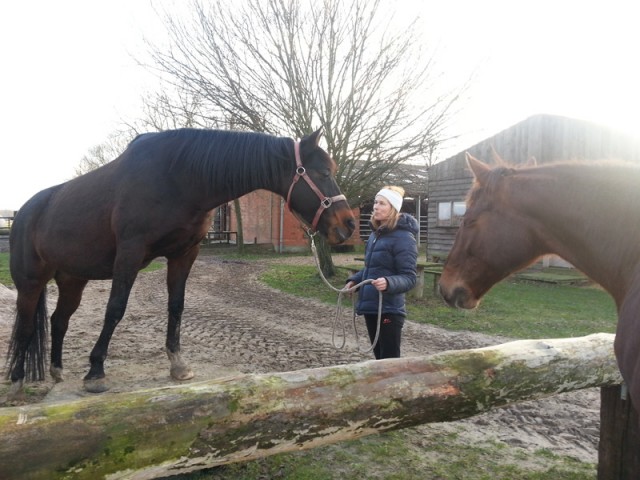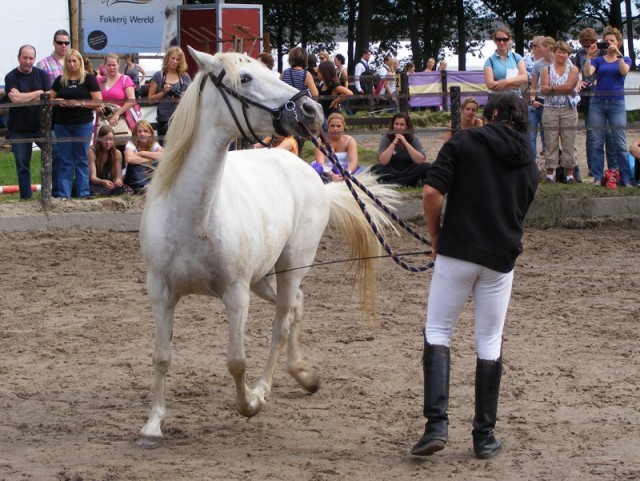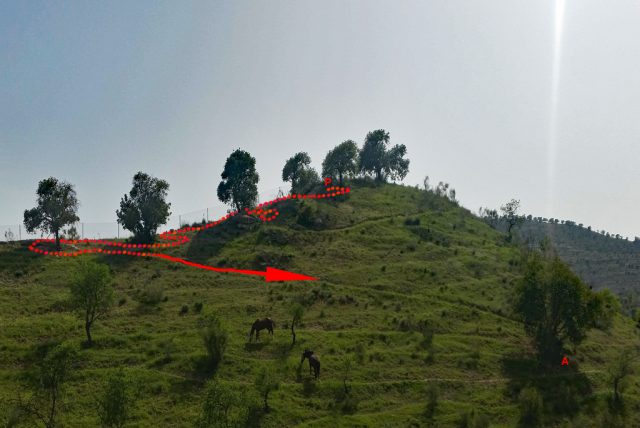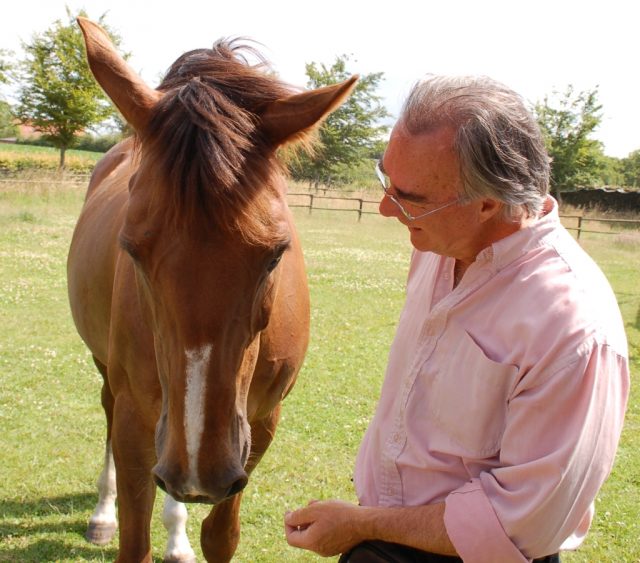 Most of the ‘horsey’ humans whom I know will readily concede that horses are capable of learning from each other. All of us seem to have a story to illustrate the point. One of my favourite stories concerns Pip learning to step up onto a pedestal after watching Anaïs do it under Vicki’s guidance. For ages I had tried to get Pip to do the same but every time she simply walked off almost shaking her head as if to say, “You’re crazy”. Caring for Pip while she was having problems with one of her hooves was a watershed experience for us. Her attitude towards me changed completely. I did not realise just to what extent it had, until I took her to the pedestal, put my foot on it and uttered the cue, “Step”, as I had vainly done so many times before.
Most of the ‘horsey’ humans whom I know will readily concede that horses are capable of learning from each other. All of us seem to have a story to illustrate the point. One of my favourite stories concerns Pip learning to step up onto a pedestal after watching Anaïs do it under Vicki’s guidance. For ages I had tried to get Pip to do the same but every time she simply walked off almost shaking her head as if to say, “You’re crazy”. Caring for Pip while she was having problems with one of her hooves was a watershed experience for us. Her attitude towards me changed completely. I did not realise just to what extent it had, until I took her to the pedestal, put my foot on it and uttered the cue, “Step”, as I had vainly done so many times before.
She lifted her hoof slightly. I then bent down and raised it on to the edge of the pedestal to show her what I meant and then we tried the whole thing again. This time Pip simply put her foot on the pedestal and turned her head towards me as if to say, “Oh that’s what you want? Well, here you are then.” Although it was only one foot, I was suitably impressed. Then I took Pip to watch Anaïs put both front feet on the pedestal but my mare did not seem to be overly impressed. A week later I discovered why. Asking Pip to put one foot up onto the pedestal and trying not to expect anything, my mare looked at me, turned back to the pedestal and simply stepped up onto it with both front feet. The next time I asked her a week later, she promptly walked right up and over the thing. An illustrated version of this story may be found in my blog post titled Towards Riding 1: The Horse, which can be found here.
Social and individual learning
Yet, when considering the horse’s cognitive abilities, perhaps the most significant observation we may make about humans’ scientific knowledge of them is how little we know about their capacity for social as opposed to individual learning. Here ‘social learning’ refers to horses’ ability to learn from each other, as opposed to how they learn on their own or from humans. Any information that is available on the subject appears to be largely anecdotal. Given the highly sociable nature of horses, we should perhaps be alarmed by our lack of knowledge of social learning amongst horses. After all, it reflects a level of ignorance on the part of humans about what is arguably the most important aspect of the horse’s cognitive abilities – given the horse’s excessively sociable nature – which is simply inexcusable in a species that we claim to know and which has played and still plays such an important role in human history and culture. Yet this shortcoming on the part of humans is perhaps entirely understandable when viewed within the context of how we keep and relate to horses. The type and level of care that we provide to our horses is largely defined by our individual convenience and requirements, as is our approach to equine learning and human training. Our research into horses’ cognitive abilities generally reflects this preoccupation with the individual and the human, with the result that we know far more about how horses learn individually and from human training rather than what and how they learn from each other and even from us when they are authors of their own learning. The few attempts that have been made to study social learning in horses have suffered from similar limitations or worse.
Ultimately, it is only in the wild, where horses are fully capable of being the highly sociable creatures that they are, that it is possible for horses to engage in the full gamut of social learning available to them and hence for humans to study this as extensively. While some work has been done in this respect, it also suffers from a serious limitation in that studies of horses in the wild tend to focus on agonistic (conflict-related) behaviour rather than affiliative (companionship-related) behaviour, with the result that sociability, which is by its very nature affiliative, is largely ignored.
Cognition and behaviourist training
Consequently, what we know about horses’ cognitive capacity is rather severely limited. Nevertheless, the relatively little that we do know reveals that horses have fairly advanced cognitive abilities which go well beyond the rather rudimentary mechanistic behaviour modification techniques which humans generally resort to for the purposes of ‘horse training’, be they of the positive or negative variety. Yet it is precisely the type of modified behaviour achieved through such techniques which is often cited as evidence of the horse’s cognitive abilities. We are told that horses excel in both non-associative learning, such as habituation, and associative learning, which takes the form of associating stimuli (classical conditioning), such as the opening of feed bins with actual feeding, or associating a stimulus with a response (operant conditioning), which can be reinforced by removing an adverse stimulus when the desired behaviour is presented (negative reinforcement) or by rewarding the desired behaviour (positive reinforcement).
Still it could be argued that, to the extent that cognition is the mental action or process of learning, knowing and understanding, any behaviour modification that occurs through such horse training is not an example of cognition in the horse or at least not fully so, as it involves little or no mental action or process, or at any rate only partially so and often only initially. This is particularly true in the case of triggered behavioural changes, which involve modified behaviour that is automatically reproduced when the trigger is invoked, thereby effectively precluding any cognitive process while the rote behaviour occurs.
Complex cognitive ability
It is possible for us to go on to cite examples of far more complex forms of cognitive ability in horses. For instance, we may mention their ability to generalise and discriminate between what they experience. They are capable of applying knowledge acquired through the performance of one particular type of action for the purposes of carrying out a related task, an example of learning to learn. Categorisation and conceptualisation are not entirely alien to them either. Horses have also been found to have excellent memories, which is the basis for learning to learn. There are also indications that horses are capable of adducing routes through terrain that they have not yet fully explored, which would suggest that they have some prospective learning potential.
Pip also showed me once that it is possible for a horse to infer meaning from a combination of original utterances expressed with the appropriate energy from a distance. She was at the top of a hill looking for her friend, Anaïs, who was gorging carob beans behind a tree towards the base of that hill. Indeed, so intent on filling her belly was Anaïs, that she did not even bother to reply to Pip’s urgent whinny. Fortunately, I saw this happening from some way off and called out directions to Pip. How she responded and eventually found her friend is described in my blog post titled Horse Training: Do We Not Hide Behind It?, which you can find here.
Ultimately though, the true test of the potential complexity of horses’ cognitive ability should focus more closely on the creature’s capacity for learning from and together with members of their own species. This is because sociability is arguably the horse’s predominant character if we base such an assessment on the time, energy and effort devoted to it in the course of interaction with other living creatures. Although human study of such social cognition amongst horses in the wild is sparse and focused primarily on agonistic behaviour, the vast extent of intensive sociability amongst them suggests that such social cognition occurs on a relatively large scale. Given that all horses in the wild are essentially feral, it would therefore be difficult not to conclude that horses in captivity could achieve and realise a similar potential in appropriate circumstances.
(Taken from the third draft of the book, Being Humans for Horses. Click here for more information.)
Equine Touch
Our Equine Touch business is called Humans for Horses, you can find our website at:
http://www.humansforhorses.com/
and our Facebook page at:
https://www.facebook.com/Humans.for.Horses
Horses and Humans on Facebook
May I remind you that we now have a Horses and Humans group on Facebook. If you would like to leave a comment, you can do so on this blog or on the the Horses and Humans Facebook group page. All new posts will feature on that page along with additional content posted by any of our members. Please feel free to join us at:
https://www.facebook.com/groups/horsesandhumans/
There is also a Horses and Humans publications page, which contains information concerning the publications released under the Horses and Humans imprint. Some of those publications will be free of charge. You will find it here:
https://www.facebook.com/horsesandhumans
I also have a Facebook page through which you may contact me. You will find it at:






